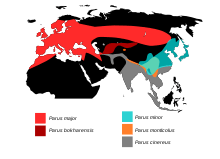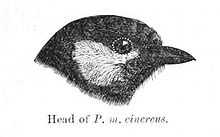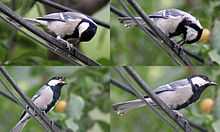Cinereous Tit
| Cinereous Tit | |
|---|---|
 | |
| Parus cinereus probably caschmirensis (Kullu, India) | |
| Scientific classification | |
| Kingdom: | Animalia |
| Phylum: | Chordata |
| Class: | Aves |
| Order: | Passeriformes |
| Family: | Paridae |
| Genus: | Parus |
| Species: | P. cinereus |
| Binomial name | |
| Parus cinereus Vieillot, 1818[1] | |
 | |
| Distribution of related species based on Eck & Martens (2006)[2] | |
| Synonyms | |
|
Parus major pro parte | |
The Cinereous Tit (Parus cinereus) is a species of bird in the tit family Paridae. This species is made up of several populations that were earlier treated as subspecies of the Great Tit (Parus major). These birds are grey backed with white undersides. The Great Tit in the new sense is distinguishable by the greenish-back and yellowish underside.[3][4] The distribution of this species extends from parts of West Asia across South Asia and into Southeast Asia.
Description

Like others in the genus, it has a broad black ventral line and has no crest. This tit is part of a confusing group of species but is distinct in having a grey-back, black hood, white cheek patch and a white wing-bar. The underparts are white with the black central stripe running along the length. The female has a narrower ventral line and is slightly duller.[5] The upper tail coverts are ashy while the tail is black with the central 4 pairs of feathers ashy on the outer webs and all but the central pair are tipped white. The fifth pair is white with a black rachis and a band of black on the inner web. The outermost pair of tail feathers are all white with a black shaft. The undertail coverts are black towards the centre but white on the sides.[6]
Taxonomy and systematics
Several of the subspecies formerly placed within Parus major are now placed in this species (all of which have a grey rather than greenish back[3][6][7] as adults, although young birds show some green on the back and yellowish on the underside[8] ). These geographically separated populations show differences mainly in the shade of grey, the extent of white on the tail feathers and in size, although the variation in size is mainly clinal:[9][10]
- cinereus Vieillot, 1818 nominate form from Java and the Lesser Sundas
- intermedius Zarudny, 1890 - Iran and Turkmenistan
- decolorans Koelz, 1939 - Afghanistan and Pakistan.
- ziaratensis Whistler, 1929 - southern Afghanistan and west Pakistan (very pale and bluish, approaching Parus bokharensis[11])
- caschmirensis E. J. O. Hartert, 1905 - Western Himalayas (has a grey nuchal patch[6])
- nipalensis Hodgson, 1837 - Subhimalayas (includes planorum of the Punjab plains)
- vauriei Ripley, 1950 - NE India[12]
- stupae Koelz, 1939 - Peninsular India
- mahrattarum E. J. O. Hartert, 1905 - Western Ghats and Sri Lanka
- templorum Meyer de Schauensee, 1946 - W Thailand and S Indochina
- hainanus E. J. O. Hartert, 1905 - Hainan I.
- ambiguus (Raffles, 1822) - Malay Peninsula and Sumatra
- sarawacensis Slater, 1885 - Borneo
Behaviour and ecology

These birds are usually seen in pairs or small groups that sometimes join mixed-species foraging flocks.[13] They forage mainly by gleaning, capturing insects (mainly caterpillars, bugs and beetles) that are disturbed and will also feeding on buds and fruits.[14] They sometimes use their feet to hold insects which are then torn with their beak. They may also wedge hard seeds in a bark crevice before hammering them with their beak (noted in ssp. caschmirensis).[11]
The calls are a whistling titiweesi...titiweesi... witsi-seesee or other variants repeated three of four times followed by a break. The calling is particularly persistent during the breeding season. In playback experiments, the churring alarm calls of the European Parus major and Asian species are responded to by each other but the songs of the European species do not elicit much response in P. c. mahrattarum.[15] About 4 to 6 eggs form the normal clutch (9 recorded in caschmirensis with one case of two nests side by side[16]). The breeding season is summer and but dates vary across their range. Some birds may raise more than one brood. In southern India and Sri Lanka the breeding season is February to May (mainly before the Monsoons) but nests have also been seen from September to November. The nests are placed in hollows in trees or in a wall or mud-bank with a narrow entrance hole and the floor of the cavity is lined with moss, hair and feathers. They sometimes make use of the old nest of a woodpecker or barbet.[17] Both parents take part in incubation and hissing from within the nest when threatened.[11] They may also roost in cavities such as those in cut bamboo.[18]
A species of flea Ceratophyllus gallinae has been recorded in their nests from India.[19] [20]
References
- ↑ Baker, ECS (1913). "Birds". Records of the Indian Museum 8: 259–288.
- ↑ Eck S & J Martens (2006). "Systematic notes on Asian birds. 49. A preliminary review of the Aegithalidae, Remizidae and Paridae". Zoologische Mededelingen 80–5.
- ↑ 3.0 3.1 Packert, Martin; Jochen Martens, Siegfried Eck, Alexander A Nazarenko, Olga P. Valchuk, Bernd Petri, Michael Veith (2005). "The great tit (Parus major) – a misclassified ring species". Biological Journal of the Linnean Society 86 (2): 153–174. doi:10.1111/j.1095-8312.2005.00529.x.
- ↑ Kvist, Laura;, Jochen Martens, Hiroyoshi Higuchi, Alexander A Nazarenko, Olga P Valchuk, and Markku Orell (2003). "Evolution and genetic structure of the great tit (Parus major) complex". Proceedings of the Royal Society B 270 (1523): 1447–1454. doi:10.1098/rspb.2002.2321. PMC 1691391. PMID 12965008.
- ↑ Rasmussen, PC & JC Anderton (2005). Birds of South Asia: The Ripley Guide. Volume 2. Smithsonian Institution and Lynx Edicions. p. 527.
- ↑ 6.0 6.1 6.2 Blanford WT (1889). The Fauna of British India, Including Ceylon and Burma. Birds. Volume 1. Taylor and Francis, London. pp. 73–79.
- ↑ Packert, Martin; Jochen Martens (2008). "Taxonomic pitfalls in tits – comments on the Paridae chapter of the Handbook of the Birds of the World". Ibis 154 (4): 829–831. doi:10.1111/j.1474-919X.2008.00871.x.
- ↑ Baker, ECS (1924). The Fauna of British India, Including Ceylon and Burma. Birds 1 (2 ed.). Taylor and Francis, London. pp. 74–78.
- ↑ Hartert, Ernst (1905). "Miscellanea Ornithologica; Critical, nomenclatorial, and other notes, mostly on Palaearctic birds and their allies. Part II". Novitates Zoologicae 12: 497–503.
- ↑ Baker, ECS (1920). "Handlist of the birds of the Indian Empire". J. Bombay Nat. Hist. Soc. 27 (2): 228–247.
- ↑ 11.0 11.1 11.2 Ali, S & S D Ripley (1998). Handbook of the birds of India and Pakistan 9 (2 ed.). Oxford University Press. pp. 168–175. ISBN 0-19-562063-1.
- ↑ Ripley,SD (1950). "Notes on Indian birds. III. Birds from Assam". Postilla 1: 1–4.
- ↑ Whistler, Hugh (1949). Popular handbook of Indian birds (4 ed.). Gurney and Jackson, London. pp. 18–20. ISBN 1-4067-4576-6.
- ↑ Mason C W & Lefroy H M (1912). Food of birds in India. Memoirs of the Department of Agriculture in India, Entomology Series 3. Imperial Department of Agriculture in India. pp. 1–367.
- ↑ Sasvári1, Lajos (1980). "Different responsiveness of Indian and European Great Tit (Parus major mahrattarum; P. m. major) to acoustic stimuli". Journal of Ornithology 121 (4): 391–396. doi:10.1007/BF01643334.
- ↑ Whistler, H (1923). "Double nest of the Kashmir Great Tit Parus major kashmiriensis". J. Bombay Nat. Hist. Soc. 29 (3): 837.
- ↑ Hume, AO (1889). The nests and eggs of Indian birds 1 (2 ed.). R H Porter, London. pp. 31–34.
- ↑ George, J (1965). "Grey Tit roosting in a bamboo stump". Newsletter for Birdwatchers 5 (5): 8.
- ↑ Hicks, Ellis A (1959). Checklist and bibliography on the occurrence of insects in birds' nests. Iowa State College Press, Ames. p. 506.
- ↑ Bacot, A (1914). "A study of the bionomics of the common rat fleas and other species associated with human habitations, with special reference to the influence of temperature and humidity at various periods of the life history of the insect". Journal of Hygiene - Plague Supplement 3, 8th report on plague investigations in India: 447–654.
External links
| Wikimedia Commons has media related to Parus cinereus. |